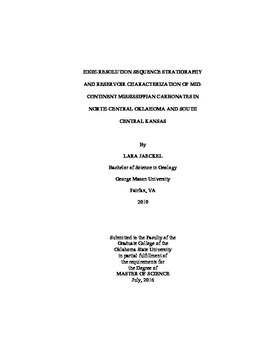| dc.description.abstract | Mid-Continent Mississippian carbonates, known informally as the �Mississippian Lime�, constitute unconventional carbonate reservoirs (low porosity and/or low permeability) with significant hydrocarbons (2+ BBO). The �Mississippian Lime� is aerially extensive (spanning hundreds of miles across Arkansas, Missouri, Oklahoma and Kansas) and represents a dynamic set of carbonate depositional systems. The reservoirs are heterogeneous and the current limited understanding of the depositional system makes the prediction of lateral facies distribution difficult.Facies identified from core and thin section analysis from north-central Oklahoma and south central Kansas indicates that deposition of the �Mississippian Lime� most likely occurred within a regionally pervasive, distally-steepened carbonate ramp environment. Results from the Oklahoma cores (Albus 1-34H and Bann 1-14) indicate that overall shoaling-upward packages are characterized by dolomitized mudstones (Oklahoma Facies 1, porosity range 4.5 � 10.9%, permeability range 0.002 � 0.011 mD) at the base that progress into higher energy grainstones (Oklahoma Facies 4, porosity range 5.4 � 14.3%, permeability range 0.0003 � 3.06 mD) at the top, some of which are associated with subaerial exposure features (porosity range 9.2 � 22.6%, permeability range 0.022 � 100 mD). Results from the Kansas core (Trophy Farms 32-34-16 1H) also exhibited shoaling-upward packages, starting with skeletal wackestones (Kansas Facies 1, porosity 0.7%, permeability 0.0001 mD) at the base and progressing into crinoidal grainstones (Kansas Facies 4, porosity range 0.6 � 7.3%, permeability range 0.0001 � 3.9 mD) at the top. Moldic, vuggy and interparticle porosity represent the most common pore types observed in thin section and hand sample for all three cores.The sequence stratigraphic hierarchy of the �Mississippian Lime� in these cores display a threefold hierarchy that can be defined as probable 3rd order sequences containing high-frequency 4th order sequences and probable 5th order cycles, which were formed due to variations in eustatic and relative sea level. Reservoir development within the �Mississippian Lime� appears to be controlled by the 3rd order sequences as the primary reservoir facies for all three cores are related to the regressive phase of the interpreted 3rd order sequences. In the Oklahoma cores, the reservoir facies is compartmentalized through intercalation of cemented grainstone and impermeable mudstone layers. In the Kansas core, the reservoir facies appears compartmentalized by impermeable wackestone intervals. Employing an integrated approach utilizing core and wireline log analysis to identify facies and to interpret depositional environments for the associated regional facies distribution, combined with the development of a sequence stratigraphic framework to enhance chronostratigraphic correlation provides a means to better understand and predict the reservoir distribution and lateral and vertical variability in these �Mississippian Lime� reservoirs. | |
